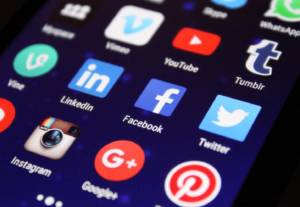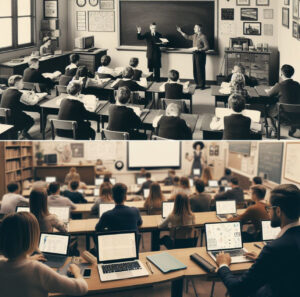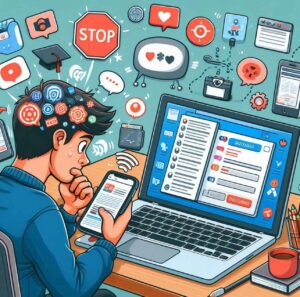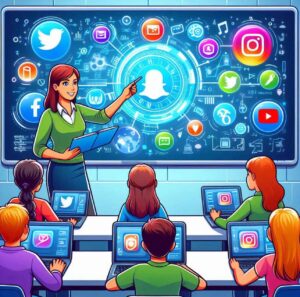Welcome Blessings!
(Tap 🔽 to see more topics!)


Social media… it’s woven into the fabric of our daily lives. It’s where we catch up with friends, share funny videos, and scroll through endless feeds. But it’s not just about selfies and hashtags anymore. Social media is quietly but powerfully reshaping how we learn, talk to each other, and even experience education. It’s changing the game in a lot of ways. And while it can be incredibly inspiring and open up incredible new possibilities, it can also have some surprising and, sometimes, even concerning effects.
How often have you learned something new from a social media post or connected with someone who shares your interests? It’s easy to see the potential for good. But then there’s the other side- the distractions, misinformation, the pressure to present a perfect image. It’s a complex landscape, and the truth is that its impact on education is vast and often unexpected.
What’s going on regarding learning and social media? Is it the fantastic educational tool we sometimes imagine, or is it creating more problems than we realize? Let’s look and unpack the ten surprising truths about how it is changing education in ways you probably haven’t even considered.

Let’s begin with the not-so-pretty side. Social media is a major distraction for students. Imagine trying to focus on your studies while your phone buzzes every few minutes with notifications, likes, and messages. It’s like trying to read a book with loud music blasting in the background. Research shows that the average person switches their attention every few seconds, and social media plays a huge part in this constant distraction.
This fragmented attention span makes it harder for students to focus on tasks that require deep thinking, such as studying for exams or completing assignments. It’s no surprise that academic performance can suffer when social media is constantly vying for attention. The question becomes: How can students and educators manage this distraction?
One solution is digital detoxing– setting boundaries around its use during study times. Turning off notifications and using tools like apps to block distracting websites during study sessions can help students stay focused and improve productivity. The struggle is real, but it’s manageable with the right strategies.
On a more inspiring note, social media is helping build a global classroom. Students from different countries, cultures, and backgrounds can now collaborate and share ideas. Whether discussing science with students from Japan, exchanging ideas about literature with peers in the UK, or participating in a global debate on climate change, social media has made education a truly international experience.
Platforms like Twitter, LinkedIn, and Facebook groups are changing how students connect with their peers and teachers. By joining niche communities or following educational accounts, students can learn from experts in various fields and get instant feedback on their work. It’s like having the whole world at your fingertips!
This transformation helps students learn the content, develop cross-cultural communication skills, and develop a global mindset. As we move further into a connected world, this social media aspect will only grow in importance.
While social media connects us in beautiful ways, it also has a dark side. Misinformation is rampant, and unfortunately, students often receive false or misleading information. Anyone can post anything from distorted historical facts to fake science claims, and this content can quickly spread like wildfire.
Imagine a student researching a historical event only to find conflicting stories from unreliable sources. The temptation to take the first piece of information at face value can be substantial, primarily if it supports their beliefs. However, in social media, critical thinking has become a crucial skill.
Students must learn to differentiate between credible sources and unreliable ones. Educators also need to emphasize the importance of digital literacy, teaching students how to evaluate sources and think critically about what they see online. Social media can be a great educational tool but requires careful use.

One of the most exciting aspects of social media is its potential to spark creativity. Platforms like Instagram, TikTok, and YouTube are overflowing with educational content that is both creative and engaging. Students can express themselves through videos, artwork, music, and more, using these platforms to showcase their talents and connect with others who share their interests.
For example, a student who loves science can create a fun TikTok video explaining a concept, or an art student can use Instagram to share their sketches and receive feedback. This freedom of expression isn’t just for entertainment—it’s an educational tool that encourages students to think outside the box and approach learning more hands-only.
It can also be a collaborative space where students collaborate on projects, brainstorm ideas, and share their creative process. It’s a digital playground for innovation and a space where students can experiment without the traditional boundaries of the classroom.
While social media has its perks, it also has a dark side when it comes to mental health. The pressure to present a curated, perfect life online can overwhelm students. The constant comparisons to others can lead to feelings of inadequacy, anxiety, and depression. Social media can create a false sense of reality, and students may struggle to separate their online persona from their true selves.
Imagine this: a student scrolls through Instagram and sees their friends posting about their latest accomplishments, travels, or social events. Meanwhile, they might feel left out or like they’re not measuring up. The pressure to keep up with these images of perfection can negatively affect mental well-being.
The good news? Social media can also support mental health. Students can find communities where they share their experiences, seek advice, and access mental health resources. The key is creating a balance—being mindful of how social media is impacting their mental state and seeking help when needed.
Gone are the days when students had to rely on textbooks, encyclopedias, or even Google searches to learn something new. Today, they turn to social media to consume bite-sized information that’s easy to digest. TikTok, for instance, is filled with educational videos covering everything from math formulas to history lessons.
This shift is pushing students to learn in more dynamic, interactive ways. Social media encourages visual learning, where students can watch short videos or view infographics to grasp complex concepts. It’s faster and more engaging, but it also requires a different kind of focus and attention span.
However, there’s a catch: while quick information is easily accessible, it can lack the depth that more traditional methods provide. Students must be mindful of this and use social media as a supplementary tool, not a replacement for more thorough research.
Social media has made it easier than ever to create academic communities. Whether it’s joining a Reddit thread about a favorite book, participating in a Facebook group for AP Chemistry, or following a LinkedIn learning group, students are finding ways to connect with like-minded peers and experts.
These communities are invaluable because they offer support, share resources, and encourage learning. They give students access to mentorship and a safe space to ask questions, discuss challenges, and share ideas. It’s a virtual classroom without walls, and the connections formed can last long beyond graduation.
For students looking to stand out in the job market, social media offers a powerful tool for building a personal brand. LinkedIn, Twitter, and even Instagram allow students to showcase their skills, interests, and projects in front of potential employers or collaborators.
Students can build an online presence that showcases their expertise by sharing their accomplishments, engaging in industry discussions, and posting their work. It’s not just about getting likes; it’s about positioning oneself as a thought leader in their field of interest. It is particularly valuable for students pursuing media, tech, or art careers, where showcasing one’s work is key to landing opportunities.
Social media isn’t just for students but for anyone wanting to learn. Platforms like YouTube, LinkedIn Learning, and Twitter have become hotspots for lifelong learners. Adults not enrolled in traditional educational programs can still access courses, tutorials, and webinars on various topics.
This democratization of knowledge means that learning doesn’t have to stop after graduation. It’s an ongoing process, and social media is making it more accessible. Whether learning a new language, picking up coding skills, or exploring philosophy, social media is where knowledge never stops.
Looking ahead, it’s clear that social media will continue to play a significant role in education. The lines between traditional classrooms and online learning are becoming increasingly blurred, and social media is leading this charge. From virtual classrooms to interactive learning sessions, students will continue to use these platforms to connect, learn, and collaborate.
As educators embrace new tools and approaches, social media will become a central education hub. It’s not just a passing trend—it’s the future of learning.

Social media is a double-edged sword when it comes to education. It’s clear it’s here to stay and can change how we learn. Kids can connect with experts across the globe, collaborate on projects with classmates anywhere, and even explore topics through engaging videos and interactive content. It can spark creativity and a love of learning that lasts a lifetime. Imagine a student in a small town connecting with a scientist studying the Amazon rainforest – that’s the kind of opportunity social media can unlock.
But, just like anything powerful, there’s a downside. It’s easy to get distracted by endless scrolling, and telling what’s real and fake news can be challenging. Plus, spending too much time online can affect a student’s mental well-being. It’s like having a delicious dessert – a bit can be fantastic, but too much can make you sick.
How do we ensure social media helps education instead of hurting it? It’s all about finding that sweet spot. We need to teach students how to use these tools responsibly, spot misinformation, and balance screen time with real-life experiences. Educators also need support in integrating social media effectively into their lessons, turning potential distractions into engaging learning opportunities.
The bottom line? The future of learning is social. It’s woven into the way we communicate and access information. But we can’t just go for it without thinking. We must be thoughtful, intentional, and mindful about using social media in education. Let’s work together to ensure it’s a force for good, opening up a world of learning for every student. Voila! Until next time!